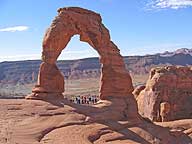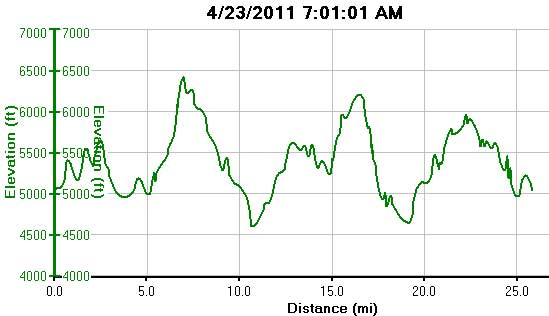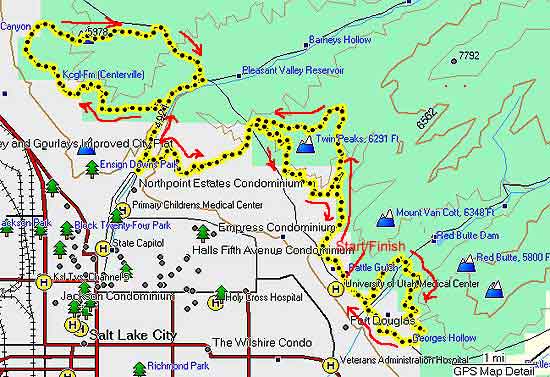 |
Adventures in Camping, Backpacking, Trail Running, and Canyoneering Boneville Shoreline Trail Marathon |
|
Cut-Off Times | Race Description
This is a physically-demanding course in the middle of the spring season. With a number of climbs and the mixture of potential rain and snow, it can tax your legs and mind, but it can serve as a great warm up for other summer trail races.
There was no specific cut-off time for this race.
Over the years, I have become pretty familiar with certain parts of the course, so rather than use my time to film and take pictures with my tripod as usual, I thought I would actually "run" the course. I have never been a fast runner, so once again, I was hoping to have a good time and try to come in around 6:30. Just under 100 people gathered in the parking lot, and after a brief race overview, the runners were off. The weather was a little cool, so I was glad I had a warm shirt for the first 4.5 miles of the course that made a loop on the Bonneville Shoreline Trail above Red Butte Garden and the new Natural History Museum that is still under construction. For the first 100 meters or so, I just tried to get in the groove on the dirt road until the first climb where the course turned into a single-track trail. This section thing drops down, crosses a stream running out of Red Butte Resouvior, and then does a few climbs and drops over the next two miles when it finally drops down into George's Hollow, returning back to the parking lot and the first aid station. Knowing that I would return back this way, I had decided to leave my hydration pack there and I would simply pick it up as I came by. This section was somewhat uneventful: no falls, no slips, and no snarling rattlesnakes or terantulas that you can come across along this route. At the aid station, I grabbed my belt before starting the section up Dry Creek Canyon. With the recent rain and heavy snow soaking up the ground, this section was unusually wet with plenty of flowing water coming down the canyon. After making an initial feeble attempt to jump over the water hole, I realized doing so was rather pointless, so I just ran threw the rest of them. Unbeknownst to many, there are a number of unique features off the main trail that would be worth a return visit with more time and patience. I have also run across fox, deer, and elk on hikes in this area, and cougar sightings are not so uncommon.
Back to the race . . . From the mouth of Dry Canyon, you climb a few hundred feet for a mile until you leave the main trail for a major climb at a major switchback in the trail heading to the west. If you are visiting this area on your own, you will notice just before the switchback a trail leading off to the east. Following this section will take you to some interesting vistas; however, if you are following the race route, you want to leave Dry Creek trail right as the switchback heads west and drop down into a normally-dry creek bed (from early summer through the winter) heading north. As was the case in this race, water from the spring runoff often flows through this section, and there was no use in trying to stay out of the water, so people simply sloshed through it for about .25 miles until you leave the creekbed and start a steep climb for about .5 miles until you reach an old jeep trail at the ridgeline. This previous section is always slow-going for me. For the next three miles, the course followed a combination of single-track and jeep trail mainly downhill until the aid station at mile 9. Because this station would also serve as the next aid station 12 miles later, and there wouldn't be any other aid in between, I filled my bottle, grabbed a few snacks, and was off, making a short climb, then across an open meadow, and then dropping down into City Creek Canyon.
Up until this point, I hadn't paid much attention to other runners around me. With a trail race in which runners spread out over the miles, you sometimes lose track of where you are in relationship to others, and this is one of the reasons why I enjoy trail running so much. You don't have the distraction of rap bands, traffic, and an audience around you. In trail racing, people tend to be encouraging, and if you decide to walk or just bend over to tie your shoe, no one mistakes this for your giving up. As I started to make the climb out of City Creek Canyon, I saw one man in front of me pulling away and a woman in a white shirt behind me gaining ground. I'm not a very fast uphill walker, but I tried to keep a decent pace. As the trail leveled out a little bit, I passed a couple of runners, and I seemed to be increasing my pace all the way to the radio towers at about mile 14. Got there at about 3 hours. "Hmmm. Can I finish the race under 6? Probably not."
And the woman in the white shirt? It seemed that I had put a gap between me and her, with a couple of runners up ahead of me. I don't think that I am atypical in the sense that you try to measure your progress by the runners around you, and I have learned that just because you have someone in your rearview mirror doesn't mean that they will stay that way. Some races are very long, and anything can happen. As I made the long climb up to Meridian Peak, I exchanged light banter with a man from Orem who was doing the race for the first time. In the 2009 edition of the race, there was a heavy fog blanketing this portion of the race, so you take in the scenery around you. This year, it was pretty clear, and you could see for miles.
Once at the top, you run for a few minutes until you drop back down into City Creek Canyon. My knees protested a little bit, so I slowed the pace until the route drops down parallel to the road. And the woman in the white shirt? Right behind me. I thought I had gained a little, but the descent was a little steep for me. The next mile or so was uneventful and easier to run, but once I started climbing out City Creek Canyon, the wheels started coming off like someone had attached a lead anchor to the back of me. For a few minutes, I seemed resigned to do more walking the rest of the race, and at mile 19, well, I guess I could have finished that way. But just then, the woman in the white shirt came up from behind, mentioned that she had been right behind me for most of the race, and cheerfully passed me by. Hmmm. Unbeknownst to me, perhaps I had been her pacer for some time, but I thought that if I could just stay a little behind her, I had some chance of reaching the end the the race still running and on my feet. After mile 21 and the last aid station, I mainly walked the next one-mile section. Again, I'm pretty slow on uphill sections of runs, so the woman in the white shirt (she introduced herself as Betsy) caught up with me (I had passed her right before the last aid station), and we exchanged some brief comments about the race, and I slowed down again. I could see other runners about a half mile ahead of me on the relatively flat single-track trail, and I thought I might be able to pick up some time at that point.
For the next couple of miles, I felt pretty good, and my unoffical pacer and I took turns working our way around the mountain. It was at that point that I realized that a sub 6-hour time would be possible, but it would be close. Furthermore, the thought of competing changed to friendly encouragement. As I dropped down into Dry (very wet) Creek Canyon, I had forgotten about the amount of water along the trail. I tried to tiptoe around one when I realized that it wasn't feasible or efficient in getting to the end with only a few minutes left. I encouraged Betsy to take the lead, and once we left the canyon, I knew that with about five minutes left to reach the 6-hour goal, making the last short climb up to the higher portion of the Bonneville Shoreline Trail would have to be quick. Once at the top, it was just a matter of barreling down to cross the finish line just under 6 hours.
As always, your feelings, motivation, and fatigue tend to fluctuate throughout a race like this, but the thought of completing a hard race keeps you going. Thanks for hosting a great race with friendly volunteers and fellow runners.
|
| Other Sites |


